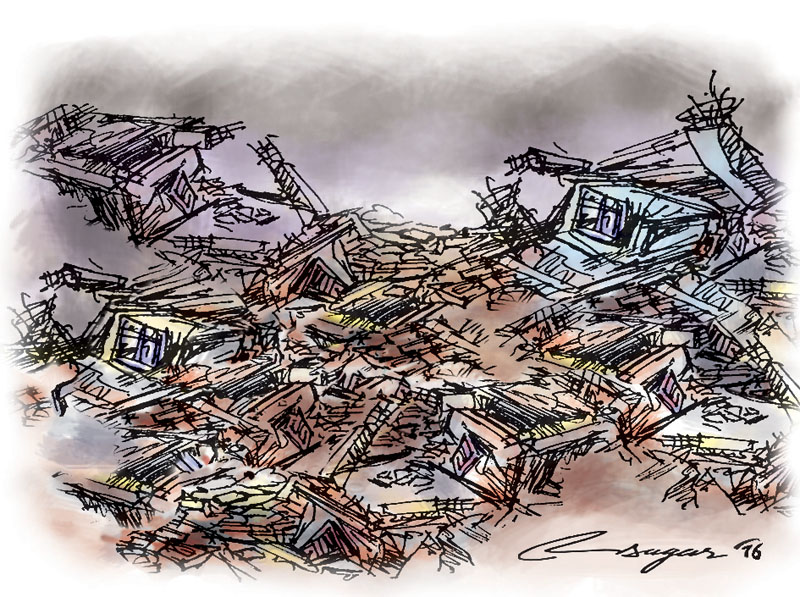Living with earthquakes: Fortune favours the prepared
The lessons of rapid reconstruction from Bhuj (India), preparedness paradigm from Maule Chile earthquake of 2010 and preventive measures against failure of reconstruction delay from the Haiti quake should be brainstormed
Commemorating the anniversary of the great Nepal-Bihar earthquake of 1990, Nepal observed the 18th Earthquake Safety Day on 2 Magh, 2072. Long swaths of time after the devastating earthquake of magnitude 7.8 in the Richter scale and the strong aftershock sequence, Nepal is switching towards the reconstruction phase. Nepal is designated to be 11th most vulnerable region as depicted by UNDP and the seismic risk will be ad infinitum, and surely will project exponentially due to socio-economic variants and marginal constructions--more commercialized and under-considered with regard to seismic and multifaceted disaster safety. The Nepali quake is placed between Haiti and Chile earthquakes of 2010. The former was some 40 times weaker and the latter was 50 times stronger than the Gorkha earthquake. Haitian paradigm has awakened the world in terms of post-quake reconstruction failure. However the Chile earthquake mirrors the efficacy of prevention and preparedness and proper implementation of seismic codes--surely structural damage is the most dominant factor for casualties and property loss. The loss of US$ 7 billion is irreparable, and 8790 casualties are also tragic. Nepal should learn from the Chile earthquake of 2010; indeed fortune favours the prepared ones!
It is believed that the anthropogenic activities are more brutal towards earthquake impacts rather than the earthquake itself, and evidently it has been verified by the Gorkha seismic sequence. After enforcement of building codes in 2003, Nepal’s journey has begun into the direction towards resilience though progress is yet to be visible and pragmatic. The engineered constructions of Lalitpur sub-metropolitan city have justified the widened discrepancy between imposing something rather than nothing at all. The damage intensity could be said to be nominal for Lalitpur sub-metropolitan city, as it has endorsed and ensured at least some mandatory rules of thumb for construction. All other newly baptized as well as reluctant cities can learn from this paradigm. Reconstruction in any area should be properly assured with a standard level of seismic safety--surely the emotionally beautiful and aesthetic plans may not necessarily reflect seismic demands and associated seismic considerations and details. Moreover, we should not devalue the role of construction site soil--as reflected in some parts of Sitapaila and Gongabu during the 2015 Gorkha earthquake.
The Disaster Management Act should come into effect so as to address the multifaceted disasters in Nepal as sagacious planning is needed before the much discussed and less exercised reconstruction kicks off. Eighteen years of continuous dedication towards seismic safety in Nepal will then only bear fruit. The future will be surely more challenging in terms of growing urbanization, mushrooming population and marginal suburban and village constructions which survived during 1988 and 2015 earthquakes which, however, are fragile and waiting for only minor shakes to be knocked off. Reconstruction can’t stride cornering such constructions, otherwise future consequences will overrun the Gorkha earthquake damage statistics both in terms of casualties as well as economic losses.
During the Gorkha earthquake the widespread challenge leading to damage was poor workmanship even if the design was satisfactory, and rural housing is never designed. It is very true that some exhibitions in cities displayed with flexes without overlooking the availability of materials, identifying the seismic behavior and selecting proper sites of reconstruction assured that the imminent threats will be dyslexic and will trespass the seismic standard of performance. Indeed single reconstruction model will be suitable throughout the areas to be reconstructed, and it should be well accounted that unless local resources are optimally used, the government promised budget will be drop in the ocean!
Observing National Earthquake Safety Day also means that it should deal with some promising issues like adequate seismic code camouflaged with available resources, technical competencies and more localized construction guidelines. Rambling and unconstrained practices of construction are to be monitored along with the rocketed incremental constructions across the cityscape. This is high time for Nepal to rethink over the scattered settlements--Nepal can choose clustered cityscapes where multifaceted disasters are neutralized with preparedness. Imperative to mention is, there are 83 open spaces in Kathmandu valley; however some four million people wanted to stay there after 25 Gorkha earthquake. This is enough to rethink over the populous landscapes like Kathmandu, otherwise the 18th National Earthquake Safety Day will be only the continuation of ‘DROP, COVER and HOLD ON’ drill day with some simulations irrespective of the structural safety considerations.
The lessons of rapid and efficacious reconstruction from Bhuj (India), preparedness paradigm from Maule Chile earthquake of 2010 and preventive measures against failure of reconstruction delay and failure from the 2010 Haiti earthquake should be brainstormed in cerebral discussions. Undoubtedly quakes may rattle in future; however, improvised coping will downscale the severity and it’s always true, ‘Fortune favours the prepared only’.






